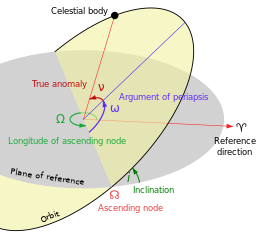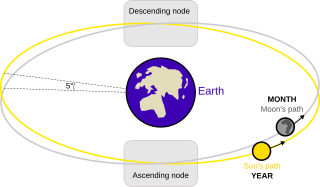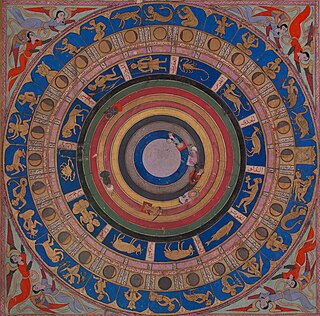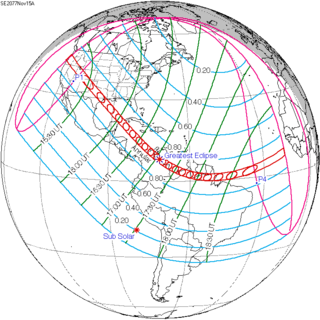
| Part of a series on |
| Astrodynamics |
|---|
| |
An orbital node is either of the two points where an orbit intersects a plane of reference to which it is inclined. [1] A non-inclined orbit, which is contained in the reference plane, has no nodes.

| Part of a series on |
| Astrodynamics |
|---|
| |
An orbital node is either of the two points where an orbit intersects a plane of reference to which it is inclined. [1] A non-inclined orbit, which is contained in the reference plane, has no nodes.
Common planes of reference include the following:

If a reference direction from one side of the plane of reference to the other is defined, the two nodes can be distinguished. For geocentric and heliocentric orbits, the ascending node (or north node) is where the orbiting object moves north through the plane of reference, and the descending node (or south node) is where it moves south through the plane. [4] In the case of objects outside the Solar System, the ascending node is the node where the orbiting secondary passes away from the observer, and the descending node is the node where it moves towards the observer. [5] , p. 137.
The position of the node may be used as one of a set of parameters, called orbital elements , which describe the orbit. This is done by specifying the longitude of the ascending node (or, sometimes, the longitude of the node.)
The line of nodes is the straight line resulting from the intersection of the object's orbital plane with the plane of reference; it passes through the two nodes. [2]
The symbol of the ascending node is ![]() (Unicode: U+260A, ☊), and the symbol of the descending node is
(Unicode: U+260A, ☊), and the symbol of the descending node is ![]() (Unicode: U+260B, ☋).
(Unicode: U+260B, ☋).
In medieval and early modern times, the ascending and descending nodes of the Moon in the ecliptic plane were called the "dragon's head" (Latin : caput draconis, Arabic : رأس الجوزهر ) and "dragon's tail" (Latin : cauda draconis), respectively. [6] : p.141, [7] : p.245 These terms originally referred to the times when the Moon crossed the apparent path of the sun in the sky (as in a solar eclipse). Also, corruptions of the Arabic term such as ganzaar, genzahar, geuzaar and zeuzahar were used in the medieval West to denote either of the nodes. [8] : pp.196–197, [9] : p.65, [10] : pp.95–96
The Koine Greek terms αναβιβάζων and καταβιβάζων were also used for the ascending and descending nodes, giving rise to the English terms anabibazon and catabibazon. [11] [12] : ¶27

For the orbit of the Moon around Earth, the plane is taken to be the ecliptic, not the equatorial plane. The gravitational pull of the Sun upon the Moon causes its nodes to gradually precess westward, completing a cycle in approximately 18.6 years. [1] [13]
The image of the ascending and descending orbital nodes as the head and tail of a dragon, 180 degrees apart in the sky, goes back to the Chaldeans; it was used by the Zoroastrians, and then by Arabic astronomers and astrologers. In Middle Persian, its head and tail were respectively called gōzihr sar and gōzihr dumb; in Arabic, al-ra's al-jawzihr and al-dhanab al-jawzihr — or in the case of the Moon, ___ al-tennin. [14] Among the arguments against astrologers made by Ibn Qayyim al-Jawziyya (1292–1350), in his Miftah Dar al-SaCadah: "Why is it that you have given an influence to al-Ra's [the head] and al-Dhanab [the tail], which are two imaginary points [ascending and descending nodes]?" [15]

The ecliptic or ecliptic plane is the orbital plane of Earth around the Sun. From the perspective of an observer on Earth, the Sun's movement around the celestial sphere over the course of a year traces out a path along the ecliptic against the background of stars. The ecliptic is an important reference plane and is the basis of the ecliptic coordinate system.

The full moon is the lunar phase when the Moon appears fully illuminated from Earth's perspective. This occurs when Earth is located between the Sun and the Moon. This means that the lunar hemisphere facing Earth—the near side—is completely sunlit and appears as an approximately circular disk. The full moon occurs roughly once a month.

In astronomy and navigation, the celestial sphere is an abstract sphere that has an arbitrarily large radius and is concentric to Earth. All objects in the sky can be conceived as being projected upon the inner surface of the celestial sphere, which may be centered on Earth or the observer. If centered on the observer, half of the sphere would resemble a hemispherical screen over the observing location.

In astronomy, the ecliptic coordinate system is a celestial coordinate system commonly used for representing the apparent positions, orbits, and pole orientations of Solar System objects. Because most planets and many small Solar System bodies have orbits with only slight inclinations to the ecliptic, using it as the fundamental plane is convenient. The system's origin can be the center of either the Sun or Earth, its primary direction is towards the March equinox, and it has a right-hand convention. It may be implemented in spherical or rectangular coordinates.

Eclipses may occur repeatedly, separated by certain intervals of time: these intervals are called eclipse cycles. The series of eclipses separated by a repeat of one of these intervals is called an eclipse series.
The saros is a period of exactly 223 synodic months, approximately 6585.321 days, or 18 years, 10, 11, or 12 days, and 8 hours, that can be used to predict eclipses of the Sun and Moon. One saros period after an eclipse, the Sun, Earth, and Moon return to approximately the same relative geometry, a near straight line, and a nearly identical eclipse will occur, in what is referred to as an eclipse cycle. A sar is one half of a saros.

A lunar node is either of the two orbital nodes of the Moon, that is, the two points at which the orbit of the Moon intersects the ecliptic. The ascending node is where the Moon moves into the northern ecliptic hemisphere, while the descending node is where the Moon enters the southern ecliptic hemisphere.

Lunar precession is a term used for three different precession motions related to the Moon. First, it can refer to change in orientation of the lunar rotational axis with respect to a reference plane, following the normal rules of precession followed by spinning objects. In addition, the orbit of the Moon undergoes two important types of precessional motion: apsidal and nodal.
A geocentric orbit, Earth-centered orbit, or Earth orbit involves any object orbiting Earth, such as the Moon or artificial satellites. In 1997, NASA estimated there were approximately 2,465 artificial satellite payloads orbiting Earth and 6,216 pieces of space debris as tracked by the Goddard Space Flight Center. More than 16,291 objects previously launched have undergone orbital decay and entered Earth's atmosphere.

The longitude of the ascending node is one of the orbital elements used to specify the orbit of an object in space. It is the angle from a specified reference direction, called the origin of longitude, to the direction of the ascending node (☊), as measured in a specified reference plane. The ascending node is the point where the orbit of the object passes through the plane of reference, as seen in the adjacent image.

The argument of periapsis, symbolized as ω, is one of the orbital elements of an orbiting body. Parametrically, ω is the angle from the body's ascending node to its periapsis, measured in the direction of motion.
Mean longitude is the ecliptic longitude at which an orbiting body could be found if its orbit were circular and free of perturbations. While nominally a simple longitude, in practice the mean longitude does not correspond to any one physical angle.

A lunar standstill or lunistice is when the Moon reaches its furthest north or furthest south point during the course of a month. The declination at lunar standstill varies in a cycle 18.6 years long between 18.134° and 28.725°, due to lunar precession. These extremes are called the minor and major lunar standstills.

The Moon orbits Earth in the prograde direction and completes one revolution relative to the Vernal Equinox and the stars in about 27.32 days and one revolution relative to the Sun in about 29.53 days. Earth and the Moon orbit about their barycentre, which lies about 4,670 km (2,900 mi) from Earth's centre, forming a satellite system called the Earth–Moon system. On average, the distance to the Moon is about 385,000 km (239,000 mi) from Earth's centre, which corresponds to about 60 Earth radii or 1.282 light-seconds.
The semi-analytic planetary theory VSOP is a mathematical model describing long-term changes in the orbits of the planets Mercury to Neptune. The earliest modern scientific model considered only the gravitational attraction between the Sun and each planet, with the resulting orbits being unvarying Keplerian ellipses. In reality, all the planets exert slight forces on each other, causing slow changes in the shape and orientation of these ellipses. Increasingly complex analytical models have been made of these deviations, as well as efficient and accurate numerical approximation methods.
A near-equatorial orbit is an orbit that lies close to the equatorial plane of the object orbited. Such an orbit has an inclination near 0°. On Earth, such orbits lie on the celestial equator, the great circle of the imaginary celestial sphere on the same plane as the equator of Earth. A geostationary orbit is a particular type of equatorial orbit, one which is geosynchronous. A satellite in a geostationary orbit appears stationary, always at the same point in the sky, to observers on the surface of the Earth.

Some medieval Muslims took a keen interest in the study of astrology, partly because they considered the celestial bodies to be essential, partly because the dwellers of desert-regions often travelled at night, and relied upon knowledge of the constellations for guidance in their journeys.

An annular solar eclipse will occur on Monday, November 15, 2077, with a magnitude of 0.9371. A solar eclipse occurs when the Moon passes between Earth and the Sun, thereby totally or partially obscuring the image of the Sun for a viewer on Earth. An annular solar eclipse occurs when the Moon's apparent diameter is smaller than the Sun's, blocking most of the Sun's light and causing the Sun to look like an annulus (ring). An annular eclipse appears as a partial eclipse over a region of the Earth thousands of kilometres wide. The path of annularity will cross North America and South America. This will be the 47th solar eclipse of Saros cycle 134. A small annular eclipse will cover only 93.71% of the Sun in a very broad path, 262 km wide at maximum, and will last 7 minutes and 54 seconds. Occurring only 4 days after apogee, the Moon's apparent diameter is smaller.

In positional astronomy, two astronomical objects are said to be in opposition when they are on opposite sides of the celestial sphere, as observed from a given body.

In lunar calendars, a lunar month is the time between two successive syzygies of the same type: new moons or full moons. The precise definition varies, especially for the beginning of the month.